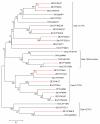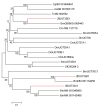454 pyrosequencing based transcriptome analysis of Zygaena filipendulae with focus on genes involved in biosynthesis of cyanogenic glucosides
- PMID: 19954531
- PMCID: PMC2791780
- DOI: 10.1186/1471-2164-10-574
454 pyrosequencing based transcriptome analysis of Zygaena filipendulae with focus on genes involved in biosynthesis of cyanogenic glucosides
Abstract
Background: An essential driving component in the co-evolution of plants and insects is the ability to produce and handle bioactive compounds. Plants produce bioactive natural products for defense, but some insects detoxify and/or sequester the compounds, opening up for new niches with fewer competitors. To study the molecular mechanism behind the co-adaption in plant-insect interactions, we have investigated the interactions between Lotus corniculatus and Zygaena filipendulae. They both contain cyanogenic glucosides which liberate toxic hydrogen cyanide upon breakdown. Moths belonging to the Zygaena family are the only insects known, able to carry out both de novo biosynthesis and sequestration of the same cyanogenic glucosides as those from their feed plants. The biosynthetic pathway for cyanogenic glucoside biosynthesis in Z. filipendulae proceeds using the same intermediates as in the well known pathway from plants, but none of the enzymes responsible have been identified. A genomics strategy founded on 454 pyrosequencing of the Z. filipendulae transcriptome was undertaken to identify some of these enzymes in Z. filipendulae.
Results: Comparisons of the Z. filipendulae transcriptome with the sequenced genomes of Bombyx mori, Drosophila melanogaster, Tribolium castaneum, Apis mellifera and Anopheles gambiae indicate a high coverage of the Z. filipendulae transcriptome. 11% of the Z. filipendulae transcriptome sequences were assigned to Gene Ontology categories. Candidate genes for enzymes functioning in the biosynthesis of cyanogenic glucosides (cytochrome P450 and family 1 glycosyltransferases) were identified based on sequence length, number of copies and presence/absence of close homologs in D. melanogaster, B. mori and the cyanogenic butterfly Heliconius. Examination of biased codon usage, GC content and selection on gene candidates support the notion of cyanogenesis as an "old" trait within Ditrysia, as well as its origins being convergent between plants and insects.
Conclusion: Pyrosequencing is an attractive approach to gain access to genes in the biosynthesis of bio-active natural products from insects and other organisms, for which the genome sequence is not known. Based on analysis of the Z. filipendulae transcriptome, promising gene candidates for biosynthesis of cyanogenic glucosides was identified, and the suitability of Z. filipendulae as a model system for cyanogenesis in insects is evident.
Figures







Similar articles
-
Cyanogenic glucosides in the biological warfare between plants and insects: the Burnet moth-Birdsfoot trefoil model system.Phytochemistry. 2011 Sep;72(13):1585-92. doi: 10.1016/j.phytochem.2011.02.023. Epub 2011 Mar 21. Phytochemistry. 2011. PMID: 21429539 Review.
-
Chemical defense balanced by sequestration and de novo biosynthesis in a lepidopteran specialist.PLoS One. 2014 Oct 9;9(10):e108745. doi: 10.1371/journal.pone.0108745. eCollection 2014. PLoS One. 2014. PMID: 25299618 Free PMC article.
-
The cyanogenic glucoside composition of Zygaena filipendulae (Lepidoptera: Zygaenidae) as effected by feeding on wild-type and transgenic lotus populations with variable cyanogenic glucoside profiles.Insect Biochem Mol Biol. 2007 Jan;37(1):10-8. doi: 10.1016/j.ibmb.2006.09.008. Epub 2006 Oct 4. Insect Biochem Mol Biol. 2007. PMID: 17175442
-
Evolution of the Biosynthetic Pathway for Cyanogenic Glucosides in Lepidoptera.J Mol Evol. 2018 Jul;86(6):379-394. doi: 10.1007/s00239-018-9854-8. Epub 2018 Jul 4. J Mol Evol. 2018. PMID: 29974176
-
Cyanogenesis in plants and arthropods.Phytochemistry. 2008 May;69(7):1457-68. doi: 10.1016/j.phytochem.2008.02.019. Epub 2008 Mar 18. Phytochemistry. 2008. PMID: 18353406 Review.
Cited by
-
Transcriptome sequencing and de novo analysis for Yesso scallop (Patinopecten yessoensis) using 454 GS FLX.PLoS One. 2011;6(6):e21560. doi: 10.1371/journal.pone.0021560. Epub 2011 Jun 24. PLoS One. 2011. PMID: 21720557 Free PMC article.
-
Spatial separation of the cyanogenic β-glucosidase ZfBGD2 and cyanogenic glucosides in the haemolymph of Zygaena larvae facilitates cyanide release.R Soc Open Sci. 2017 Jun 28;4(6):170262. doi: 10.1098/rsos.170262. eCollection 2017 Jun. R Soc Open Sci. 2017. PMID: 28680679 Free PMC article.
-
De novo transcriptomic resources for two sibling species of moths: Ostrinia nubilalis and O. scapulalis.BMC Res Notes. 2013 Feb 28;6:73. doi: 10.1186/1756-0500-6-73. BMC Res Notes. 2013. PMID: 23445568 Free PMC article.
-
From RNA-seq to large-scale genotyping - genomics resources for rye (Secale cereale L.).BMC Plant Biol. 2011 Sep 28;11:131. doi: 10.1186/1471-2229-11-131. BMC Plant Biol. 2011. PMID: 21951788 Free PMC article.
-
Assessing De Novo transcriptome assembly metrics for consistency and utility.BMC Genomics. 2013 Jul 9;14:465. doi: 10.1186/1471-2164-14-465. BMC Genomics. 2013. PMID: 23837739 Free PMC article.
References
-
- Nahrstedt A. In: Proceedings of the 5th International Symposium on the Biology of the Zygaenidae (Insecta, Lepidoptera) Tremewan WG, Wipking W, Naumann CM, editor. Grietherbusch (Germany): Koeltz Scientific books; 1993. Cyanogenesis in the Zygaenidae (Lepidoptera): a review of the state of the art; pp. 17–29.
-
- Bak S, Paquette SM, Morant M, Rasmussen AV, Saito S, Bjarnholt N. Cyanogenic glycosides; a case study for evolution and application of cytochromes P450. Phytochemistry rev. 2006;5:309–329. doi: 10.1007/s11101-006-9033-1. - DOI
-
- Duffey SS. In: Cyanide in Biology. Vennesland B, Conn EE, Knowles CJ, Westley J, Wissing F, editor. London: Academic press; 1981. Cyanide and Arthropods; pp. 385–414.
-
- Davis RH, Nahrstedt A. In: Comprehensive Insect Physiology, Biochemistry and Pharmacology. Kerkut GA, Gilbert LI, editor. Oxford: Pleanum Press; 1985. Cyanogenesis in insects; pp. 635–654.
Publication types
MeSH terms
Substances
LinkOut - more resources
Full Text Sources
Miscellaneous

